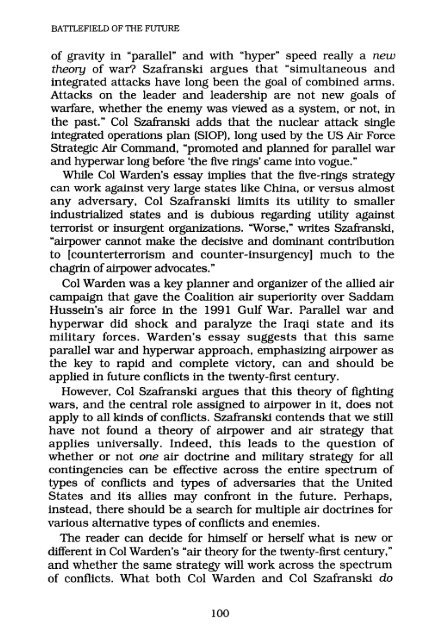BATTLEFIELD OF THE FUTURE
Battlefield of the Future - Air University Press
Battlefield of the Future - Air University Press
You also want an ePaper? Increase the reach of your titles
YUMPU automatically turns print PDFs into web optimized ePapers that Google loves.
<strong>BATTLEFIELD</strong> <strong>OF</strong> <strong>THE</strong> <strong>FUTURE</strong><br />
of gravity in "parallel" and with "hyper" speed really a new<br />
theory of war? Szafranski argues that "simultaneous and<br />
integrated attacks have long been the goal of combined arms .<br />
Attacks on the leader and leadership are not new goals of<br />
warfare, whether the enemy was viewed as a system, or not, in<br />
the past." Col Szafranski adds that the nuclear attack single<br />
integrated operations plan (SIOP), long used by the US Air Force<br />
Strategic Air Command, "promoted and planned for parallel war<br />
and hyperwar long before 'the five rings' came into vogue ."<br />
While Col Warden's essay implies that the five-rings strategy<br />
can work against very large states like China, or versus almost<br />
any adversary, Col Szafranski limits its utility to smaller<br />
industrialized states and is dubious regarding utility against<br />
terrorist or insurgent organizations . "Worse," writes Szafranski,<br />
"airpower cannot make the decisive and dominant contribution<br />
to [counterterrorism and counter-insurgency] much to the<br />
chagrin ofairpower advocates ."<br />
Col Warden was a key planner and organizer of the allied air<br />
campaign that gave the Coalition air superiority over Saddam<br />
Hussein's air force in the 1991 Gulf War . Parallel war and<br />
hyperwar did shock and paralyze the Iraqi state and its<br />
military forces . Warden's essay suggests that this same<br />
parallel war and hyperwar approach, emphasizing airpower as<br />
the key to rapid and complete victory, can and should be<br />
applied in future conflicts in the twenty-first century .<br />
However, Col Szafranski argues that this theory of fighting<br />
wars, and the central role assigned to airpower in it, does not<br />
apply to all kinds of conflicts . Szafranski contends that we still<br />
have not found a theory of airpower and air strategy that<br />
applies universally . Indeed, this leads to the question of<br />
whether or not one air doctrine and military strategy for all<br />
contingencies can be effective across the entire spectrum of<br />
types of conflicts and types of adversaries that the United<br />
States and its allies may confront in the future . Perhaps,<br />
instead, there should be a search for multiple air doctrines for<br />
various alternative types of conflicts and enemies .<br />
The reader can decide for himself or herself what is new or<br />
different in Col Warden's "air theory for the twenty-first century,"<br />
and whether the same strategy will work across the spectrum<br />
of conflicts . What both Col Warden and Col Szafranski do<br />
100

















